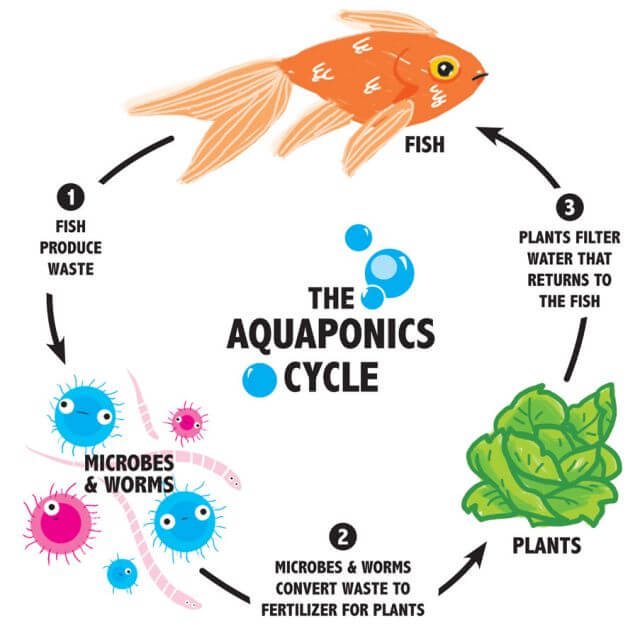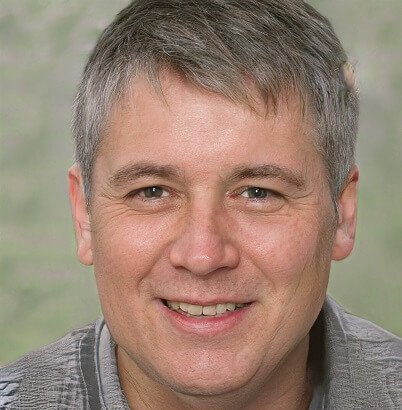Aquaponics is an effective way to grow multiple crops in a smaller space and using more environmentally friendly techniques.
Once you have the system established you’ll need to monitor the pH levels, nitrates, temperature, and several other criteria. You’ll also need to feed your fish with regular fish food or specialized aquaponics fish food.
That’s it! A well-run system will look after it’s self, the fish waste provides the nutrients the plants need and bacteria convert the ammonia into nitrites and then nitrates that provide the plants with nutrition.
The result is that crops generally grow faster thanks to your ability to control the environment they’re growing in.
But, in order for the aquaponics to work efficiently, you have to set it up properly. That includes completing aquaponics cycling and testing the system regularly.
What Is Aquaponics Cycling?
Aquaponics cycling is the process of converting ammonia in your system into nitrites and then nitrates that your plants use to grow.
The ammonia is produced by the fish, it’s their waste products. If you leave the fish in their own water, without filtering it, it will kill them and they won’t be of any benefit to the plants.
Cycling is the process by which you ready your system for the successful introduction of bacteria that convert ammonia and ammonium to nitrites and then nitrates.
Fish produce waste in which bacteria convert to nutrition for plants. However, if you introduce fish and plants as soon as you start the system there won’t be any bacteria present to convert the fish waste.
Cycling is simply the process you complete when you set up an aquaponics system, it ensures the essential bacteria are present to allow the fish and plants to be introduced and complement each other.
Why Aquaponics Cycling Is Necessary
Cycling encourages the arrival and multiplication of bacteria which convert fish waste to nitrates.
Aquaponics cycling is an essential step when starting up your system to ensure all the necessary elements for successful plant growth are present.

Cycling Options
In fact, there are two options when aquaponics cycling. The first is aquaponics cycling with fish, the second is cycling without fish. Both can work well, you simply need to choose the one that you prefer.
Aquaponics cycling takes approximately 4-6 weeks and you should maintain a water temperature of between 68°-86°F, (20°-30°C). If the temperature is not in this range, then the cycling process will take longer as the bacteria you need to convert ammonia to nitrates will not multiply as quickly as they should.
The ideal pH for Nitrosomonas and Nitrobacter bacteria to reproduce is between 7 and 8. If your water is out of these ranges, it will take longer for bacteria to develop. Never use lime to increase pH, it will kill the bacteria.
Cycling with Fish
You’ll need to create your system first, that means a tank for your fish, connections to your grow bed, the grow media, a pump, and the temperature and pH should all be right for your chosen type of fish.
With this established, you can add fish to your water. It is generally recommended that you only put a few fish in at this stage, which minimizes losses if it goes wrong. Goldfish are preferred because they are hardy fish.
At this stage, you can add a bacteria starter if you wish. This is basically adding the bacteria you need to your system to encourage them to settle and increase in population. If you don’t use a bacteria starter then the bacteria will still accumulate and multiply, it may just take a few extra days.
You can also take some existing filter material from an already existing pond to jumpstart the bacterial growth. Make sure the pond doesn’t have any parasites in it.
Once the fish are in you’ll need to start testing the water every day. The ammonia level must remain below 2.0ppm, at the same time nitrites must remain under 1.0ppm. If the ammonia levels become too high or the nitrites too low then the fish will become stressed and potentially die.
If at any time, the ammonia starts to rise above the allowed rate for your fish, stop feeding and only feed when ammonia levels are low again. So people say that ecoli is a risk in aquaponics. The risk, however, is very limited. Read more about in my article: ecoli aquaponics.
Fishless Cycling
There is no doubt aquaponics cycling is stressful for you and the fish. That’s why there is an alternative, aquaponics cycling without fish.
Again, your system will need to be established and ready for fish and plants.
However, this time you add a bacteria starter to help get the bacteria started. You’ll also need to add ammonia until the tests show it is at 4.0ppm. You can purchase ammonia in powder or liquid form and either can be used in your aquaponics cycling.
You’ll now need to perform daily tests to make sure the ammonia levels stay around 4.0ppm. You should always test before you add more ammonia and it should be 24 hrs apart. When the ammonia level has dropped to 0.5ppm and there is evidence of nitrites in the water, the cycling process has started and you can stop adding ammonia.
There are several different ways to introduce ammonia into your system:
Liquid Ammonia
If you intend to use liquid ammonia it must be pure, that’s 5-10% ammonia and the only other ingredient should be water. Any other product means you’re putting other chemicals into your system which could be detrimental to the plants or the fish.
This is potentially the cheapest option but it is increasingly difficult to find.
Ammonium Chloride – Crystallized Ammonia
This is effectively the same as liquid ammonia but much easier to find. You’ll be able to purchase this from virtually any aquarium supply store or even a photography supply store.
It’s important to note this comes in dry form and is highly concentrated although very cheap to ship.
Urine
Yes, your urine is a potent source of ammonia, in fact, so is any animal urine. The main reason to use human urine is that’s it’s the easiest to catch.
However, you should note that human urine must be put in a sealed bottle for approximately 3 weeks, this will allow the urine to turn into ammonia before you add it to your system. Adding it before it converts to ammonia means you won’t be able to track how much ammonia is going into the system and levels are likely to increase suddenly and explosively. The ammonia is the strong scent that you smell when peeing.
Dead Fish
This isn’t really the ideal approach as dead fish don’t just increase ammonia levels, they will also allow bacteria into your system and other chemical compounds; They may also attract flies. You won’t be able to control the ammonia levels easily and you’ll need to get hold of some dead fish.
If you do have a dead fish in your tank that goes unnoticed it will start to decay and increase your ammonia levels, but it will also bring an array of bacteria that you don’t want.
Conclusion on fishless cycling
The good news is that with fishless aquaponics cycling you can shorten the amount of time it takes to get your system ready. It should take 2-3 weeks instead of the 4-6 it takes with fish. This is because you can increase the amount of ammonia you put into the system to encourage bacteria growth, without worrying about killing your fish.
Cycling without fish also means you’ll be instantly able to stock your system with as many fish as you want. When you’re cycling with fish you usually need to gradually build up the fish level.
You’re now ready to add your fish to your aquaponics system. Again, don’t feed them for 24 hours.
Remember, adding ammonia is fine but should stop as soon as you add fish, only one source of ammonia is needed, and the fish can provide this.
Nitrite spike
The nitrite spike is a common occurrence in cycling a system. After the ammonia has disappeared, it will be turned into nitrite by the bacteria. Nitrite can be more toxic than ammonia.
The bacteria that convert the nitrite to nitrate takes longer to establish than the bacteria that convert ammonia to nitrite. You can only add fish into the water when nitrite levels are zero. If you add fish when nitrite is over 1ppm, your fish might die.
Final Thoughts
Performing aquaponics cycling is essential to create the right environment for your fish, plants, and even your nitrifying bacteria. It can be frustrating to wait 4-6 weeks before you can start planting but, it’s an essential part of the setup process.
Not only will your fish be happier with a well set up system; your plants are also likely to be stronger, grow faster, and potentially taste better.
The good news is that aquaponics cycling only needs to be done once. Having established the bacteria you can change plants and even fish while keeping your aquaponics system balanced and ready to use.
The bacteria naturally lower the pH of your aquaponics system. If you notice the pH increasing in your aquaponics system, it might be a sign of a decreasing bacterial colony. Clogging up of the growbeds with fish solids is one of the most frequent causes of bacterial death. Check your growbeds for trapped solids if your pH starts to increase.

Nick loves building, managing and giving others advice on aquaponics. He created this website to do just that. He is the author of Aquaponics for beginners. If you got a question contact him here or read more on the about page here.
